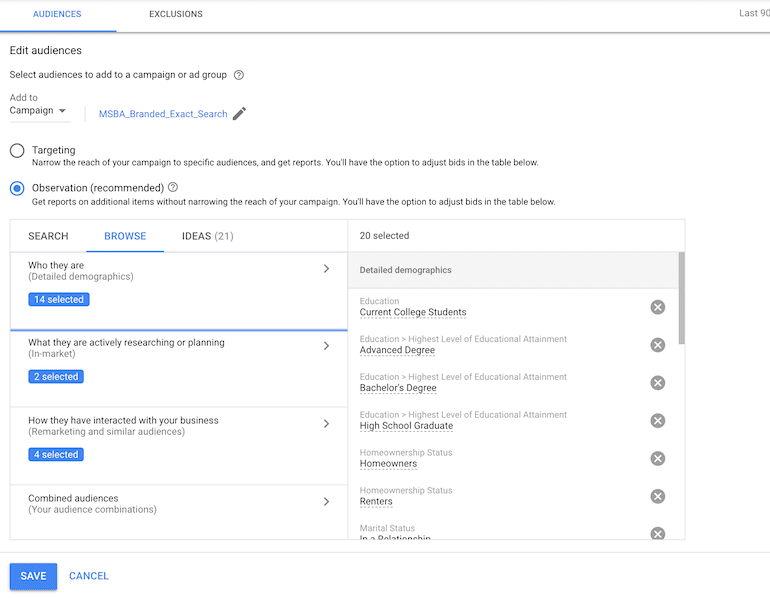In Paid Search, testing is crucial in our industry. We are always looking for new testing opportunities such as ad copy to improve user engagement and other tactics to bring down cost-per-click while also trying to achieve more leads or revenue. Sometimes clients can be hesitant to test because if a test loses they might feel like it was a waste of time or even resources. If you are in a situation where a client is hesitant about testing, the perfect gateway into testing is by testing audiences. I always pitch my audience tests as a free test because we are simply gathering data in the account while we working on our normal routines. Below I am going to list how to test and pull insights from this zero cost test.
Getting Started
Once you have the client on board with testing audiences, the implementation is simple. I layer on several types on all of my campaigns and I change the targeting setting to Observation. The goal is to allow these audiences to start collecting data while I work on other aspects of the account. If I change the settings to Target I am telling Google that I want to only target users in these buckets, but since my goal is to collect data and not eliminate data this option is not ideal. After I have received my data I might change the settings to Target if I have gleaned enough insights to do so.

These are the audiences I have currently layered in my accounts on the campaign level. You can also set this on the ad group level. At this time go crazy and add as many audiences as you like, you are just selecting groups you are interested in learning more about and there is no current limit to how many audiences you can have in your account. A quick housekeeping tip, Google does not like if you have audiences on an ad group level and a campaign level, so pick the option that works best for you and remain consistent.
- Similar Audiences – Created by Google
- In-Market Audiences – Created by Google
- Remarketing Audiences – Returning Website Visitors and Custom Email Lists
- Demographics – Age, Gender, Income Level
- Detailed Demographics – Education Level, Marital Status, Parent Status, and Homeowner Status
Gather the Data
It could take some time for Google to collect the data and place users in their different buckets. Google is not able to place every person in each audience list in your account, but you will start to see trends after each check-in. I personally check audience data once a month and look at cost, conversions, and conversions rates until I have reached enough conversions to see a trend with a particular audience. To organize my data I use Excel and pivot tables to find trends by using pivot tables. Here is our Complete Guide to Using Excel for PPC to help you find some additional tips and tricks to save you time finding these golden nuggets.
How to Apply Your insights
My best example is from an education client that offers several different MBA programs. From the Detailed Demographic audiences, I had layered on I was able to see a few trends on education level and conversions. Previously we had tried bidding on different age levels to weed out people who were currently in college and to find people with work experience.

This data shows us that we were able to gain conversion with people who were currently in college but we had a few converters that were High School Graduates and may not qualify for this program. We can add this audience as a negative to remove these users from our searches. For our Fully Employed Program (FEMBA) we have a higher conversion rate for Bachelor degree holders and we can increase our bids on this traffic and the client confirmed that this traffic was higher quality.
Once you go through your data and find areas where you can trim spend or push for more traffic, check how bidding on the audiences interact with your bidding strategy within the account. Some bidding models will adjust bids on Demographics and Device such as Enhanced CPC. With this industry, it is best to read the fine line of the bidding strategies first and to look at bidding strategy updates to make sure that your audience bids are not conflicting with your automation mode to prevent a situation where your Max CPC bid is much greater than your original intention. Here is the support page for Enhanced CPC so you can see the current ways this bidding model changes bids to help with your account initiatives.
Get Some Knowledge
Now that you know how to test audiences for free, so through and browse the different types and layer them on everything today. All of my clients have found these insights useful and they appreciate that we are using Google to our full capacity.



